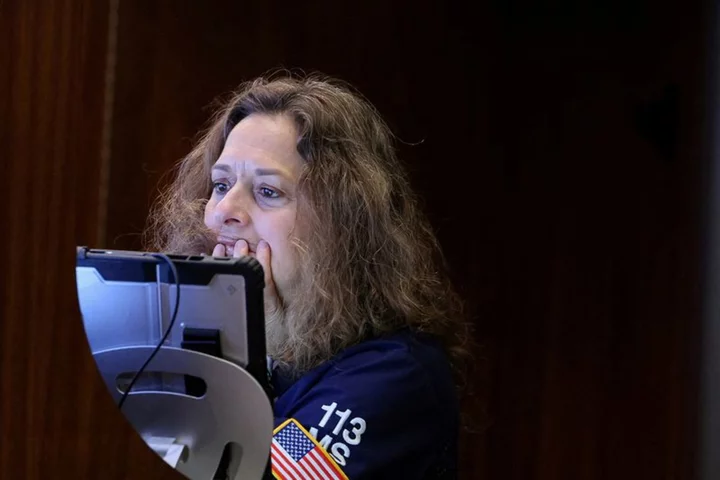By Mike Dolan
LONDON The modest reaction of global markets to the shock of another Middle East war says more about an investment world already braced for more turbulent times than nonchalance per se.
Even by the standards of recent decades, the speed with which investors shifted focus away from the deadly weekend attacks by Hamas on Israel and Israel's declaration of war in response has been extraordinary.
Israeli assets and the shekel remain under pressure and oil and gold prices are marginally higher than last week. And while it may still be early days, that's about the height of global repricing so far despite all the trepidation about 'ifs' and 'buts' and what comes next.
Pressed to make a call on it, most asset managers assume the conflict will flare for several weeks with uncertain outcomes for the people of the area. But they also bet it will remain largely local in scope with limited impact on energy prices.
"The conflict is likely to remain within Gaza and the West Bank," Amundi's chief investment officer Vincent Mortier and head of geopolitics Anna Rosenberg wrote. "The impact on markets should be limited as long as the conflict remains local."
Invesco's chief strategist Kristina Hooper reckons that based on the market performance during and after the 2014 Gaza War, there was unlikely to be any material negative impact to U.S. or global stocks long-term.
Something more akin to 1973's wider Yom Kippur War and subsequent oil surge may be a different matter, she said.
But even then, Hooper added, "it seems unlikely that we would see a major impact to global inflation."
"The real price of oil is already elevated, it is hard to imagine anything like a tripling from today's level and the global economy is far less oil intensive than it was."
To be fair, that's merely their base lines.
These investors go on to list a welter of less likely though possible escalations that could drag in more globally significant actors or energy-sensitive players such as Iran, the United States, Saudi Arabia or even Russia.
It's just that extreme 'outside risks' now attend so many of the world's mounting standoffs and flashpoints - will China invade Taiwan, for example, or could Russia use nuclear weapons in Ukraine? These are risks are now "non negligible", as wonks say, and you can't price them all and stay invested.
Headlong dashes for 'safe' assets or bunkering of savings - more typical of truly global leftfield shocks such as 2020's COVID-19 pandemic - may now be rarer in an environment where the world is assumed to be in some sort of permanent flux already.
NOWHERE TO RUN TO...
While you may assume 'tail risks' have to be absorbed somewhere into decision-making and relative pricing, it's hard to see where that might be right now - certainly not in traditional safe havens such as battered sovereign bonds or relatively subdued gold prices or even relatively calm financial volatility gauges.
A buoyant dollarDXY> and high cash holdings could reasonably be cited as reflections of global political angst - but even that's hard to disentangle from the rare interest rate squeeze of the past two years.
It's possible the macro investment world may have become more comfortable and blase about geopolitical risk after several years of dramatic twists - U.S. trade tariffs on China, a pandemic that triggered a wave of economic nationalism and supply chain reordering, Russia's invasion of Ukraine and the linked concern that China may do likewise in Taiwan.
Last updated shortly before the weekend events in Israel, BlackRock's Geopolitical Risk Indicator - which attempts to capture market attention to political risks - had indeed crept up to six month highs. But it was still far below the peaks of Ukraine invasion or pandemic lockdowns.
On the other hand, many investors reckon it may just be too hard to price extreme 'tail risks' of these sorts even if you can see them on the edge of the radar.
"Markets have a tendency to either see the risk as manageable with a minimum of price disturbance - or so calamitous that they discard the risk altogether," Amundi's Rosenberg said, adding funds preferred instead to look for opportunities, spot beneficiaries in commodities or even unexpected alliances.
Releasing its World Economic Outlook on Tuesday, the International Monetary Fund warned that more volatile commodity prices were a possible reflection of both greater climate and geopolitical risk.
"Geoeconomic fragmentation has also led to a sharp increase in the dispersion in commodity prices across regions, including critical minerals," IMF chief economist Pierre-Olivier Gourinchas said. "This could pose serious macroeconomic risks."
What's more, Gourinchas said high and stretched debt levels, rising debt servicing costs and a higher dollar were a worry.
This could lead to a sudden and "sharp repricing of risk", especially in emerging markets, that lifts the dollar further, triggers capital outflows and lifts borrowing costs and debt distress in a spiral, he said.
And yet hand wringing about geopolitical risk in different corners of the globe can also deflect from rising political risks in core economies - not the least in the United States.
With a traditional haven of U.S. Treasury debt increasingly unnerved by serial threats of government funding cutoffs, shutdowns and another contentious election on the horizon next year, its safety factor may be tarnished.
If so, a lack of market movement on stress overseas may just reflect the fact that there's nowhere left to hide.
The opinions expressed here are those of the author, a columnist for Reuters.
(Editing by Josie Kao)

